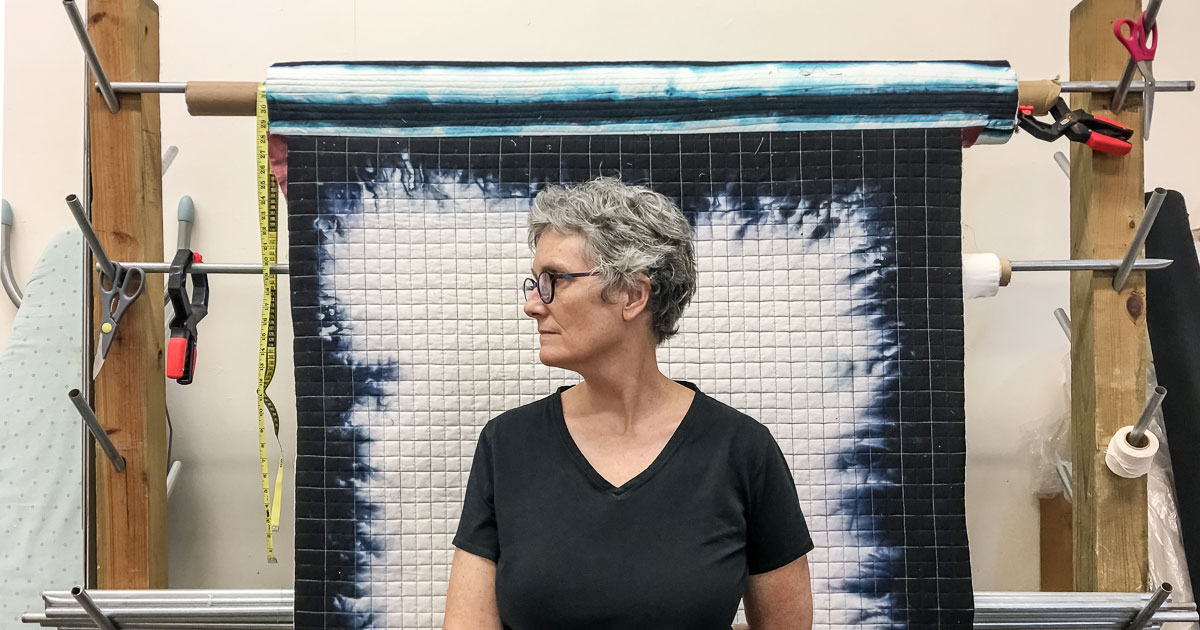Flags, rags and signs: The art of Mary Anne Jordan

LAWRENCE – On her website, Mary Anne Jordan places her hand-dyed, quilted and stitched fiber artwork into three categories: Flags, Rags and Signs. For the show opening Oct. 4 at the James May Gallery in Algoma, Wisconsin, the University of Kansas professor of visual art will exhibit artwork created in recent years as well as new work being shown for the first time.
“I have two new large pieces,” she said. “They're 125 inches wide and 45 inches tall. So they're long and narrow. They're a kind of banner or flag. I have also completed several small works about 25 inches square that are composed of fabric remnants and scraps with intensive hand stitching.”
Jordan said she likes to think of her flags and signs as warnings or acts of resistance.
“The sign series references are recognizable,” she said, “like the caution stripes on the back of an ambulance or a dead-end road sign. I like that idea of the sign as being a warning or a promise.”
Jordan also likes the idea of revealing some of her artistic process to the viewer. On her website she states that “evidence of the personal mark and human body is of the utmost importance” to her work.
In an interview, she said this is so “because we're removed from our bodies with technology. And so a mark using the hand to create a crooked line or a sloppy mark — even handwriting, shows a kind of humanness.
“In the process of making, I can make the dyes run and smear on the fabric. I control the action, but not completely. I like the idea that one can see that a person made the work and there are smudges and splotches.”
Utilizing pattern and nontraditional quilting processes, Jordan tries to infuse her work with narrative content without hitting the viewer over the head with it.
Jordan said her artwork exists on a continuum that has evolved over the years without radical breaks. She learned sewing as a child, but never made clothes, for instance. She took art classes at the Toledo Museum of Art and earned art degrees at University of Michigan and Cranbrook Academy of Art while concentrating on fiber.
“There's definitely a thread and a similarity and a continuum,” she said. “It's become more or less narrative over the years. Some of my work in the ’90s was more image-oriented. I use less images now and more pattern and color. I've gone through stages where I use more color or less color. As you can see, on my website, a lot of my current work is black and white.”
Things look pretty stark to Jordan these days.
Rags, she said, convey “the idea of domesticity and textiles that are used. Flags can represent identity, place and allegiance. Signs are warnings, announcements, notices, pleas.
“I respond a lot to the news and politics. I don't make pictures or narratives in that way, but I'm responding to contemporary issues all the time; they often converge together. I refer to contemporary issues, but I also use fabric, sewing and references to historic textiles and contemporary art to represent my feelings about current events and culture. I'm really engaged with fiber/textiles materials and processes, and I hope that they represent my ideas successfully.”
Jordan said she tries to hint at the works’ meaning in her titles.
“I also use the history of textiles and quilts in my work,” she said. “Sometimes I jack with the name of a traditional quilt pattern like 'Rocky Road to Kansas.' There are traditional patterns with references to fences and barriers like 'Railroad Crossing.' I play with those ideas to create my own patterns like 'Warning Sign' or 'Four Patch with Damage' or 'Red Alert.'”
Jordan notes that many traditional quilt-pattern names grew from hard times like the Civil War and Great Depression.
“Women were making blankets because they were cold — not for decorative purposes or art, but to keep their families warm,” Jordan said. “I'm making quilts for the wall. I recognize this ability to concentrate on artmaking as a privilege.”
Jordan will show her work at the James May Gallery with her KU colleague Marshall Maude. (See related story on him here.)
“Marshall and I have many commonalities in our work,” Jordan said. “We both use historic references from our craft while also making artwork that is aligned with contemporary art practice.”
Their work will be on display Oct. 4 through Nov. 23 at the James May Gallery.
Photo: Portrait of Mary Anne Jordan Credit: Luke Jordan